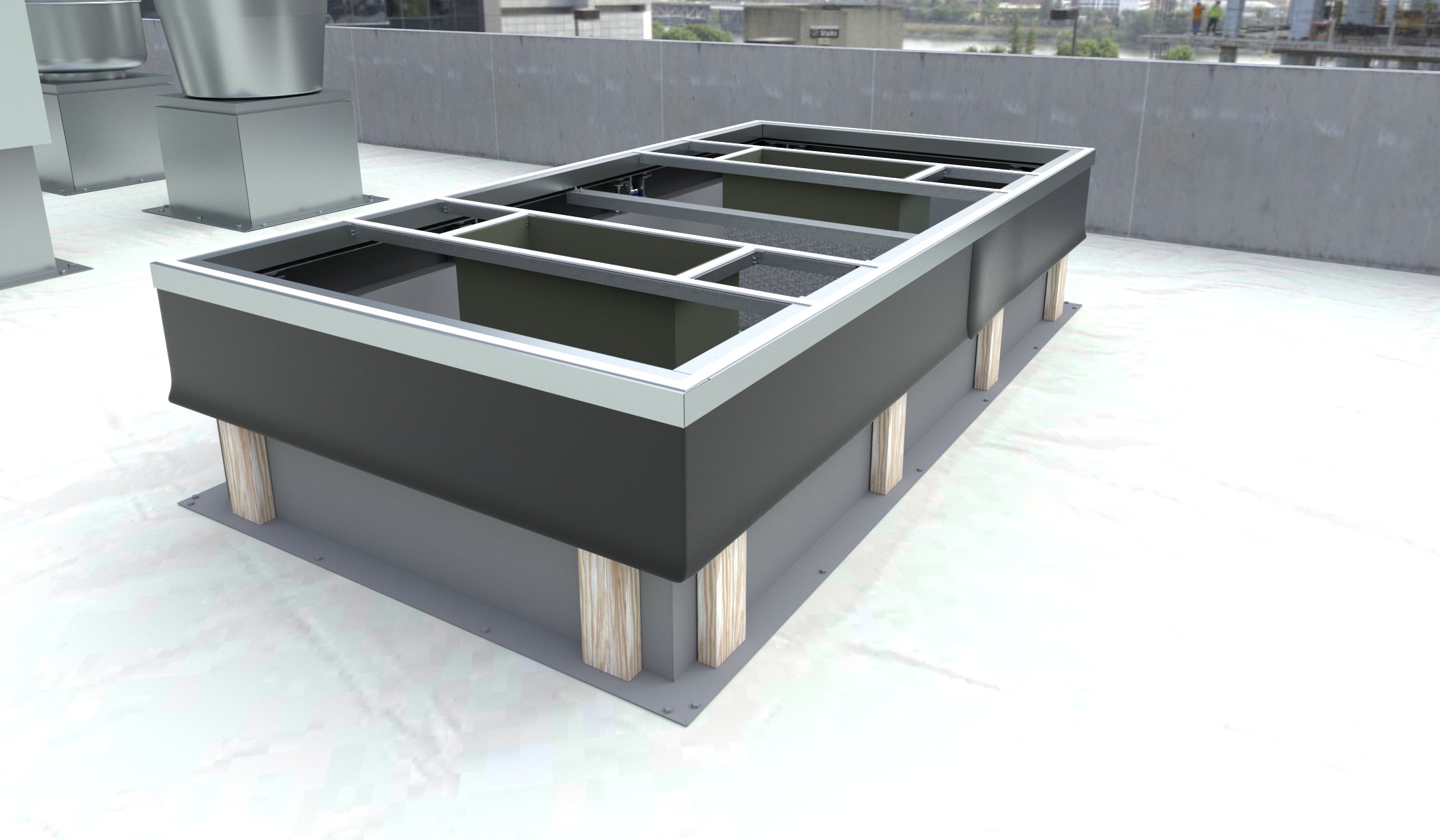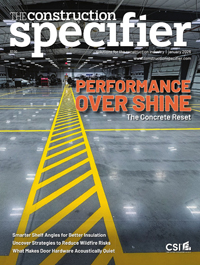Hurricanes and flooding: Advancing building strategies for resilience
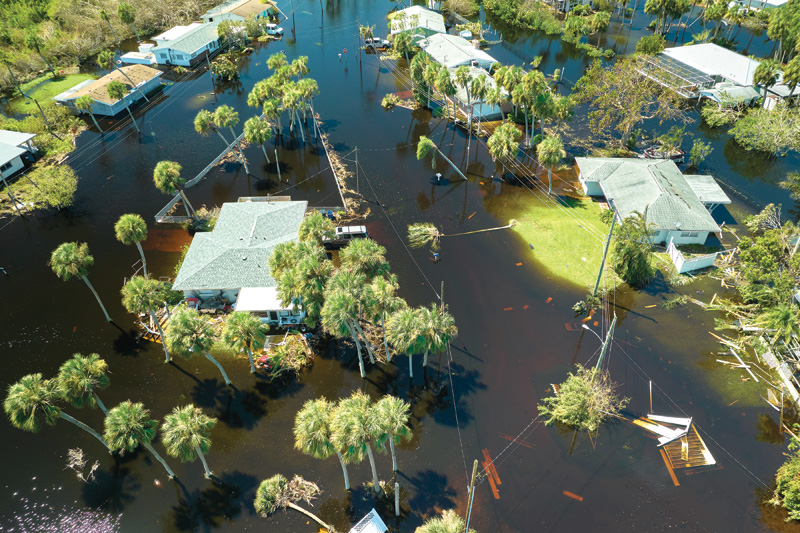
While hurricanes are often associated with high-speed winds, flooding is frequently the deadliest and most destructive consequence of these storms. Flooding is the leading cause of destruction in natural disasters across the U.S., impacting both coastal and inland regions. Riverine flooding, which occurs when rivers or streams overflow their banks due to excessive rainfall, flash floods, and urban flooding caused by heavy rainfall contribute to widespread damage nationwide. The devastating hurricanes of the 2024 season, along with severe flooding events in the Midwest and Northeast regions, have highlighted the widespread need for improved flood preparedness.
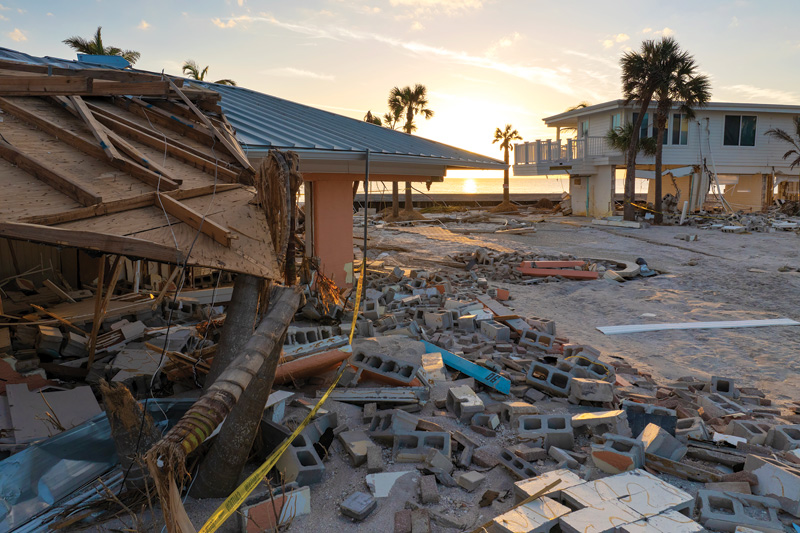
The increasing threat of flooding nationwide
Coastal regions along the Atlantic and Gulf coasts face significant flood risks from storm surges, where hurricane winds push seawater onshore, causing severe inundation. However, flood threats extend far beyond coastal areas.
Since 2000, global warming has increased the number of people living in flood-prone regions by an estimated 20 to 24 percent,1 expanding the reach of this danger. According to the National Oceanic and Atmospheric Administration (NOAA), flooding accounted for more than $200 billion in damages between 2010 and 2019, impacting approximately 90 percent of all natural disasters in the U.S.2
Even minor floods can be financially devastating. Beyond structural damage, flooding also poses serious health hazards, including mold growth, waterborne diseases, and indoor air quality (IAQ) issues. Prolonged exposure to flood-damaged environments can lead to respiratory illnesses, allergic reactions, and other long-term health concerns. The Federal Emergency Management Agency (FEMA) estimates that just 25.4 mm (1 in.) of water can cause up to $25,000 in damage to a home, affecting flooring, walls, appliances, and personal belongings. For commercial properties, the financial impact can be even greater due to larger spaces, specialized equipment, and costly business interruptions.
Several factors contribute to the growing flood risk. Rising global temperatures are driving heavier rainfall and more intense storms. At the same time, urbanization and deforestation worsen flooding by increasing surface runoff, reducing vegetation that stabilizes soil, and replacing it with increased impervious surfaces such as pavement and rooftops. Population growth is placing more people in high-risk flood zones. A 2023 report by the First Street Foundation found that 39 million properties across the U.S. are at high risk from flooding, wildfires, or hurricane winds, with 12 million of these properties facing significant flood risk outside of FEMA-designated flood zones.3 Recent major flooding events, such as the 2024 floods in the Mississippi River Basin and the devastating flash floods in Kentucky and Tennessee, highlight the widespread and escalating nature of this threat.
The need for flood-resistant designs and materials is no longer confined to coastal regions; it has become a nationwide concern. As a result, rigorous flood testing of building materials and infrastructure is essential for flood-resilient buildings and supporting post-disaster recovery efforts.
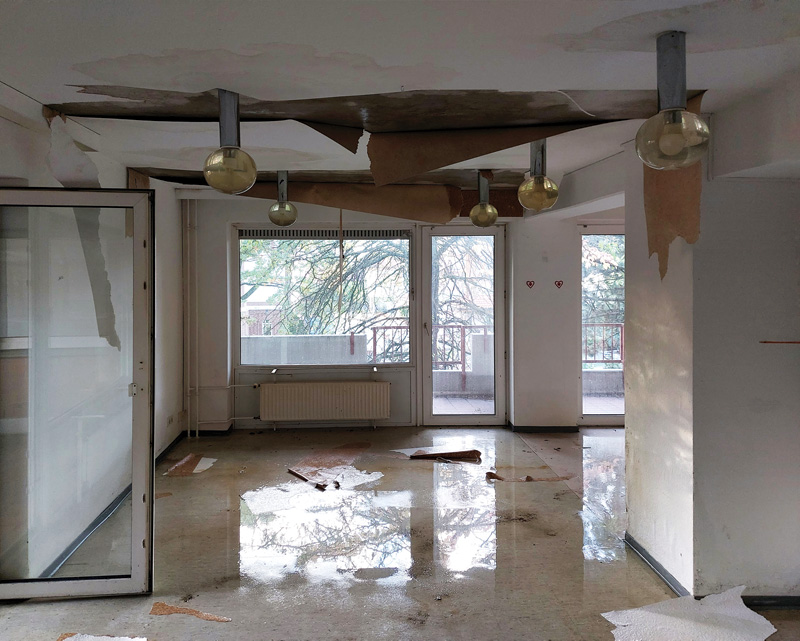
The importance of flood testing
Comprehensive flood testing strengthens infrastructure and protects communities from rising flood risks. Evaluating materials and construction techniques informs material selection, improves building methods, creates better designs, and ensures regulatory compliance. This process leads to safer and more durable structures, in addition to better flood mitigation design and implementation.
Flood testing measures how well materials and systems resist water intrusion, hydrostatic pressure, and prolonged flood exposure. Key aspects of flood testing include:
- Structural integrity assessments—Engineers analyze walls, foundations, and building envelopes to determine their ability to withstand flood-related forces such as hydrostatic and hydrodynamic pressures, soil erosion, and debris impact. These assessments support the development of reinforced foundations, flood-resistant walls, and structural retrofitting solutions to improve resilience.
- Water intrusion testing—Simulating conditions such as prolonged submersion and wind-driven rain helps measure the waterproofing efficiency and efficacy of construction materials and assemblies. This process identifies weaknesses in seals, drainage systems, and barriers to prevent water penetration and long-term moisture damage. Addressing water intrusion is important for structural integrity and preventing mold growth and indoor air contamination, which can pose severe health risks to building occupants.
- Material performance validation—The durability of flood-resistant materials, such as membranes, sealants, coatings, and barriers, is assessed through both laboratory and field testing. Key performance metrics include water resistance, permeability, tensile strength, and long-term exposure to flood conditions.
- Compliance with regulatory standards—Ensuring adherence to industry standards, including FEMA’s National Flood Insurance Program (NFIP), ASCE 24-24, Flood Resistant Design and Construction, and ICC building codes. Compliance testing confirms materials and structures meet critical safety and performance benchmarks in flood-prone areas.
- System performance optimization—The performance of flood protection systems, including floodgates, barriers, sump pumps, and drainage solutions, is evaluated to verify they meet required design and code-based performance standards. Engineers also assess opportunities for design improvements to support long-term reliability and effectiveness.
- Full-scale testing—Physical mock-ups, such as floodgates, barrier sections, and wall assemblies, are tested under controlled conditions that simulate rising water levels, wave impacts, and prolonged submersion. These evaluations provide direct data on how systems and materials perform under extreme flood conditions and help identify areas for improvement in design, durability, and installation methods.
- Simulation modeling—Digital modeling is used to evaluate large-scale or site-specific scenarios that cannot be physically replicated, such as floodplain behavior, watershed runoff, or the capacity of drainage infrastructure during extreme rainfall events. These models help engineers predict system response, assess risks, and make informed design decisions based on projected performance under various flood conditions.

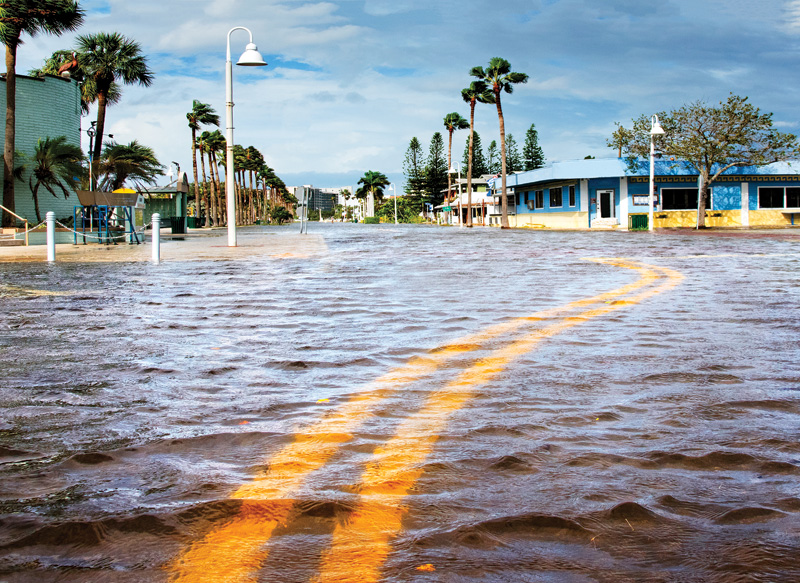
Building envelope’s role in resilient construction
One of the most vulnerable aspects of any structure during a flood is the building envelope, which includes windows, doors, roofs, and walls. Envelope compromises can lead to catastrophic failure, especially with the capabilities of
wind-driven rain and storm surges to severely damage a building’s interior and structural integrity. As the first line of defense, a
well-designed building envelope is the best opportunity to reduce flood damage and protect both structural and non-structural components.
Several engineering principles and material advancements contribute to creating flood-resilient building envelopes:
- Elevated construction—Raising the structure above projected flood levels reduces the risk of floodwaters reaching critical building systems. Techniques to comply with FEMA and ASCE flood-resistant design guidelines include constructing homes on stilts, raised foundations, or elevated slabs.
- Flood-resistant materials—Walls and floors constructed with durable, non-porous, and water-resistant materials, such as concrete, flood-resistant drywall, and closed-cell insulation, prevent water absorption, reducing mold growth and long-term structural damage.
- Sealed openings—Windows, doors, and other penetrations must be fitted with watertight gaskets, floodproof barriers, and specialized sealants to prevent water infiltration. Products that meet ASTM flood-resistant standards provide an extra layer of protection.
- Drainage and water diversion—Effective drainage systems, such as flood vents, sump pumps, and landscape grading, help redirect water away from the building, reducing hydrostatic pressure and minimizing water accumulation around the foundation.
- Reinforced structural elements—Strengthening walls, foundations, and key load-bearing components with flood-resistant concrete, steel reinforcements, and advanced coatings can help structures withstand hydrostatic and hydrodynamic forces from floodwaters.
- Impact-resistant openings—Installing high-performance impact-resistant windows and doors that comply with ASTM E1886 and E1996 provides critical protection against windborne debris and storm-driven water intrusion. While these systems are already required by code in coastal regions such as Florida, there may be additional opportunities to implement similar solutions in inland areas where severe weather events are becoming more frequent.
- Roof rainwater management—Proper roof design, including adequate slope, gutter capacity, and downspout sizing, helps manage heavy rainfall and direct water away from the structure. These measures reduce the risk of water accumulation, prevent overflow at roof edges, and protect building interiors and exterior assemblies during severe storm events. Using roofing materials that comply with FM Global and Miami-Dade TAS 110 testing reduces the risk of leaks and helps protect interior components from moisture damage.
- Protective coatings and barriers—Specialized waterproof coatings, hydrophobic sealants, and ANSI/FM 2510 flood protection systems help repel moisture, preventing long-term structural degradation.
- Site design strategies—Elevating structures, incorporating features such as bioswales (vegetated channels that slow and filter runoff), rain gardens, and permeable surfaces, and preserving natural floodplains are effective ways to reduce flood risk through site planning.
These strategies help manage stormwater at the source, reduce runoff, and improve the site’s ability to absorb or redirect water during heavy rain events. Proper site design can protect buildings, infrastructure, and surrounding areas by reducing water accumulation and minimizing flood-related damage.
By combining strategic site planning with advanced materials and construction practices, engineers and architects can create buildings that are better prepared to withstand extreme weather events and reduce the risk of costly flood damage.
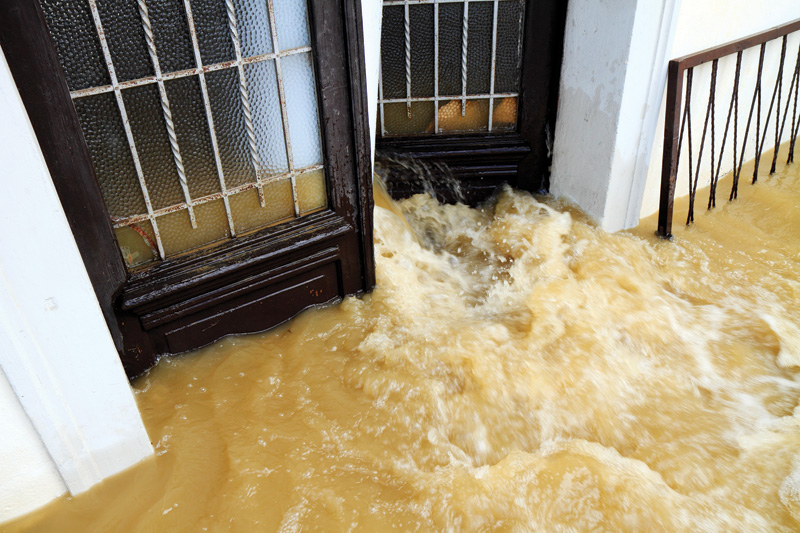
Case study: The Louisiana Children’s Museum
The Louisiana Children’s Museum in New Orleans provides a compelling example of effective flood-resilient design. Having experienced 1.2 m (4 ft) of flooding during Hurricane Katrina, the site is now engineered to retain up to 0.9 m (3 ft) of floodwater during future storms, protecting surrounding neighborhoods. The museum is elevated 1.5 m (5 ft) above grade, meeting the city’s building code requirements for hurricane-prone regions. Other flood-resistant features include native plantings to help absorb rain and flood water, a pier-based construction that allows water to flow beneath and recharge the lagoon, and open spaces that promote environmental education and flood mitigation.

The future of flood resilience
Integrating advanced flood-resistant technologies is becoming increasingly common in urban planning and infrastructure development. These technologies include permeable surfaces, smart drainage systems, and modular flood barriers. Many cities are already incorporating them into new projects to reduce flood vulnerability.
Ongoing research is driving the development of next-generation materials with improved water resistance, such as hydrophobic concrete and self-sealing flood barriers. Smart monitoring systems, leveraging sensors and AI-driven analytics, are being developed to provide real-time flood risk assessments and optimize drainage management in flood-prone urban areas. As climate change intensifies flooding threats, continued research, innovation, and adaptive policies will be essential to strengthen the built environment.
Conclusion
Extreme weather events, including floods and hurricanes, are increasing in frequency and intensity. Engineering solutions and site design principles that incorporate flood-resistant materials and systems, exceed code minimum regulatory compliance, and new technological advancements are essential for minimizing the economic and structural impact of flooding. Implementing flood testing and adaptive construction methods contributes to long-term infrastructure resilience. Ongoing research into advanced materials and AI-driven flood management systems promises to advance the effectiveness of flood mitigation strategies in both urban and coastal environments.
Notes
1 Refer to climate.gov/news-features/blogs/beyond-data/2010-2019-landmark-decade-us-billion-dollar-weather-and-climate?utm
2 Learn more at earthobservatory.nasa.gov/images/148866/research-shows-more-people-living-in-floodplains?utm
3 Read more at assets.firststreet.org/uploads/2023/09/PR_Insurance-2.pdf
Author
Vinu J. Abraham, P.E., is a licensed professional engineer with extensive expertise in addressing stringent windborne debris requirements. He is recognized for his leadership in developing protective glazing products that protect homes, businesses, and communities from severe windstorms. As vice-president of products for Intertek’s Building and Construction division, he is responsible for the growth and management of building and construction operations throughout the United States and Canada. His prior experience includes serving as CEO at Hurricane Test Laboratory, Inc., where he spearheaded critical testing initiatives in Riviera Beach, Fla., including windborne debris impact testing, pressure testing, cyclic load testing, and water penetration testing. Abraham is a member of several professional associations, including the ASCE and the National Society of Professional Engineers.
Key Takeaways
Flooding remains one of the most widespread and destructive natural hazards in the U.S., affecting both coastal and inland areas. As extreme weather events increase and development expands into high-risk zones, communities must adopt proactive strategies to enhance resilience. Comprehensive flood testing of materials and systems ensures buildings can withstand water intrusion, hydrostatic pressure, and prolonged exposure. Essential components of flood-resilient design include reinforced structures, impact-resistant openings, and advanced waterproofing. Adherence to regulatory standards supports effective protection in both new and existing structures. Investments in infrastructure—such as improved drainage, barriers, and flood-proof materials—not only help reduce economic losses and safeguard public health but also support long-term sustainability and resilience in vulnerable areas.




